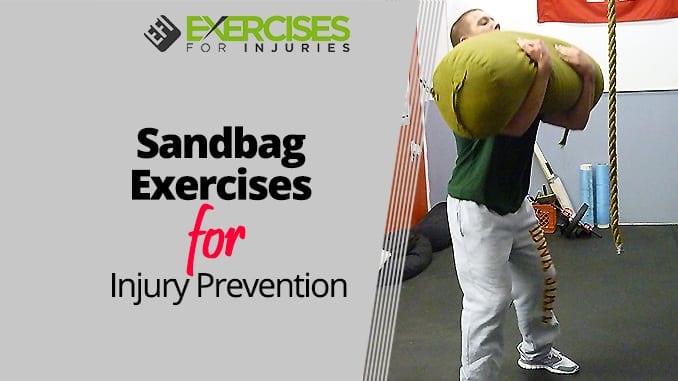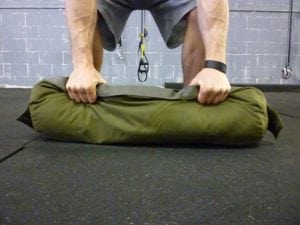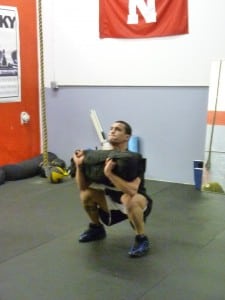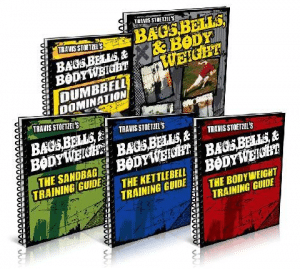Today is a little bit of a different article for you. I have a theme for you by Travis Stoetzel on Sandbag Exercises for Injury Prevention.
It is a little extreme, but after the post on Suspension Trainer for Shoulder Pain, I wanted to get information on other excellent tools for injury recovery.
Today it is about the sandbag.
A few years back, I became addicted to digging into my homemade sandbags for the first time! Having become hooked, I purchased a large quantity of professionally made sandbags. Now, I have nine sandbags strewn about my gym for good reason.
I built more power and explosiveness, plus tons of core and functional strength. But more importantly, I knew I was helping prevent injuries by training and implementing sandbag training into my routines and programs! I could tell the difference in how my body reacted to this type of training.
As a strength coach, injury prevention is the #1 priority over anything else! If you’re an athlete and get injured, you’re out of the game and therefore worth NOTHING.
At the same time, If I were training some athletes and they happened to get injured on my watch, I would be out of a job quickly. When injuries are prevented, athletes can build more strength and functionality that will ultimately cross over into their particular sport or sports using sandbags.
Along with being a HUGE means of preventing injury, sandbag training is also excellent for the reasons I discuss below.
1. Sandbags Build RUGGED Strength
When I talk about “rugged strength,” I’m talking about pure functional strength that you can use in the real world.
Strength is crucial in sports and athletics! If you can’t take the strength you build in the weight room and apply it to the playing field, your strength is worthless! My athletes must be able to cross the strength and power they gain in training into play.
In this day and age, training with machines and the newest gizmos and gadgets is becoming more and more common, which is bad for sports, athletes, and training in general. We’re getting away from the natural movements we use in sports and everyday life using machines and other useless pieces of equipment.
We need to stay more “primal” and old school with our movements to combat this. Sandbags allow us to do this!
Training with sandbags is way more functional and “free.” Free, meaning when you train with sandbags, you have to use many different muscle groups, forcing you to use your whole body as one unit. This is how we were meant to train and brings me to my next point about sandbags.
2. Sandbags help fill the holes most regular strength training programs leave open.
When you train with fixed and balanced weights like barbells and dumbbells, you leave out the truth of athletics: there is never a flat or “controlled” situation in competition and sport.
You’re constantly moving, balancing, and shifting around in most sports. Very seldom are you in a wholly balanced and controlled state as you would be when training with barbells and dumbbells. (Not to say I don’t believe in training with barbells and dumbbells because I’m all for the use of both of these pieces of equipment very much, but there needs to be a balance. Implementing the use of sandbags creates this balance).
On the other hand, sandbags shift and move, which forces you to go and move. While we’ll never be able to replicate actual competition or live events in the weight room, sandbags help close the gap between natural athletic movement and training.
3. Sandbags help build all-around power.
Since sandbags are more durable and can be thrown around better than a barbell or set of dumbbells, it’s nice to work on high-speed movements that require no eccentric phase to complete the lift. You explode by either pushing or pulling and then release the bag.
It’s nice to perform such movements as throws and tosses. With tosses and throws, it’s easy to focus on the explosive portion of the lift and not have to worry about lowering the weight back down. Put, explode, and let go.
So, why is this type of training so important for preventing injuries?
Most injuries occur in the eccentric portion of a movement. This is the “slowing down” part of a movement or exercise. With sandbags, we can take that away in some instances and lower the risk of injury if we have to.
This works great for beginners and young athletes that are not yet strong enough to deal with heavier barbells and dumbbells.
I prefer to train beginners on sandbags to help them build up higher levels of strength and power. It’s easier to teach cleans with sandbags than to lead with a barbell. Learning the essentials of using the hips to generate power is crucial for young athletes and even regular trainees. Sandbags help make the beginning stages of learning how to use your hips for control very easy.
As you can see, sandbag training can have a positive impact on your workout and your injury prevention! Sandbags can aid in building muscle, strength, and power, but one should not overlook how they can also produce mental toughness and toughness.
It all comes with the territory. Sandbags are just straight-up rugged. Period! This is another side bonus, along with all the other great additions sandbag training offers.
So, dig into a nasty sandbag today and reap the benefits!
About Travis
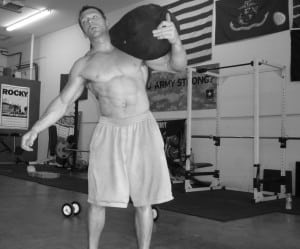
Travis does this with “underground” type training methods, including Strongman, kettlebells, ropes, chains, body weight, Olympic lifting, sandbags, sleds, and tires. He owns a small hardcore gym in Omaha, Nebraska, called the Forged Athlete, where he helps athletes and serious trainees alike accomplish their performance and physique enhancement goals.
For more information on Travis, visit his blog at TravisStoetzel.com, and you can check out his Bags, Bells & Bodyweight program for more exercises and training tips.
Huge thanks to Travis for the great article.
If you have any tips on sandbags or questions, make sure to ask by leaving a comment below.
Rick Kaselj, MS

